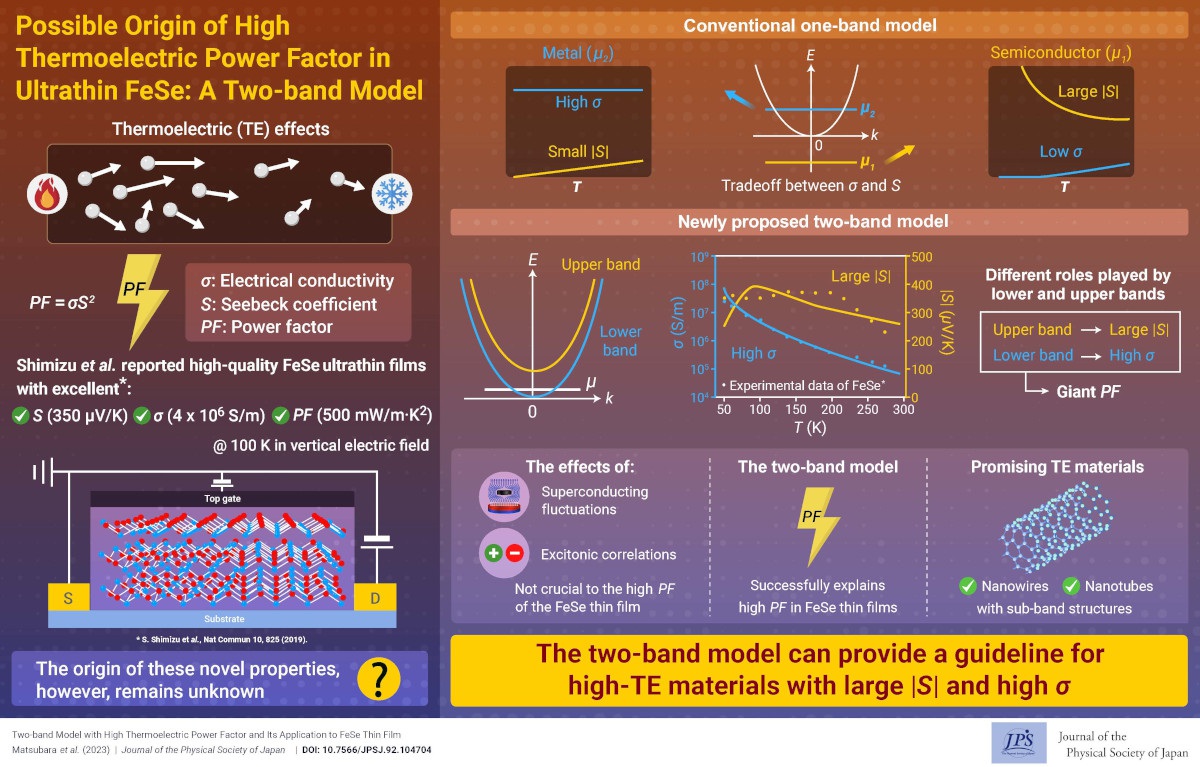Possible Origin of High Thermoelectric Power Factor in Ultrathin FeSe: A Two-band Model
© The Physical Society of Japan
This article is on
Two-band Model with High Thermoelectric Power Factor and Its Application to FeSe Thin Film
J. Phys. Soc. Jpn. 92, 104704 (2023).
The high thermoelectric power factor observed in ultrathin FeSe can be theoretically explained by a two-band model with chemical potential between upper and lower band bottoms.

Thermoelectric (TE) materials have recently garnered significant attention toward realizing a low-carbon society. The maximum power of a TE material can be characterized by the power factor (PF), which is determined as PF = σS2, where σ and S denote the conductivity and Seebeck coefficient, respectively. Thus, both a large |S| and high σ are needed for the development of high-PF materials. However, it is well known that there is a tradeoff between |S| and σ; |S| is large but σ is small in semiconductors, and vice versa in metals.
Recently, Shimizu et al. reported that a high-quality ultrathin FeSe under a perpendicular electric field  exhibits a high PF of 500 mW/(m·K2) at 100 K1). The film exhibits metallic character, with σ~4 × 106 S/m at 100 K and becomes a superconductor below 50 K. In contrast, |S| exhibits a large value of 350 μV/K, similar to that of a semiconductor. Such a high PF with both a large |S| and high σ cannot be explained in terms of a conventional one-band model. Thus, we proposed a two-band model with a chemical potential between upper and lower band bottoms as a simple theoretical model and elucidated the high PF. Here, we assumed that the two-band structure with finite splitting is realized by field
exhibits a high PF of 500 mW/(m·K2) at 100 K1). The film exhibits metallic character, with σ~4 × 106 S/m at 100 K and becomes a superconductor below 50 K. In contrast, |S| exhibits a large value of 350 μV/K, similar to that of a semiconductor. Such a high PF with both a large |S| and high σ cannot be explained in terms of a conventional one-band model. Thus, we proposed a two-band model with a chemical potential between upper and lower band bottoms as a simple theoretical model and elucidated the high PF. Here, we assumed that the two-band structure with finite splitting is realized by field  in the ultrathin FeSe.
in the ultrathin FeSe.
The present two-band model provides a guideline for designing high TE materials. For instance, nanowires and nanotubes with nanosized diameters are also promising materials with large |S| and high σ values because of sub-band structures. In contrast to FeSe thin films,  tunes the chemical potential without affecting the sub-band gap suited for optimization of TE properties.
tunes the chemical potential without affecting the sub-band gap suited for optimization of TE properties.
(Written by M. Matsubara on behalf of all the authors.)
Two-band Model with High Thermoelectric Power Factor and Its Application to FeSe Thin Film
J. Phys. Soc. Jpn. 92, 104704 (2023).
Share this topic
Fields
Related Articles
-
Electricity Provides Cooling
Magnetic properties in condensed matter
Structure and mechanical and thermal properties in condensed matter
Cross-disciplinary physics and related areas of science and technology
2024-10-15
Electric cooling at low temperatures is successfully achieved using a ferroelectric ferromagnetic solid instead of refrigerant gases such as fluorocarbons.
-
Pressure-Tuned Classical–Quantum Crossover in Magnetic Field-Induced Quantum Phase Transitions of a Triangular-Lattice Antiferromagnet
Magnetic properties in condensed matter
Electron states in condensed matter
Cross-disciplinary physics and related areas of science and technology
2024-9-5
The correspondence principle states that as quantum numbers approach infinity, the nature of a system described by quantum mechanics should match that described by classical mechanics. Quantum phenomena, such as quantum superposition and quantum correlation, generally become unobservable when a system approaches this regime. Conversely, as quantum numbers decrease, classical descriptions give way to observable quantum effects. The external approach to classical–quantum crossover has attracted research interest. This study aims to demonstrate a method for achieving such control in materials.
-
Having a Good Friend around Makes Life Better
Cross-disciplinary physics and related areas of science and technology
2024-7-29
It is true that having a good friend around makes life better, and this idea is also true in the quantum world.
-
Antiferromagnetism Induces Dissipationless Transverse Conductivity
Electronic transport in condensed matter
Magnetic properties in condensed matter
Electronic structure and electrical properties of surfaces and nanostructures
2024-7-24
An investigation using high-quality NbMnP crystals demonstrates that the anomalous Hall conductivity arising from antiferromagnetism is dissipationless, as expected from the intrinsic mechanism.
-
Evaluation of the Exchange Stiffness Constants of Itinerant Magnets from the First-Principles Calculations
Electron states in condensed matter
Structure and mechanical and thermal properties in condensed matter
2024-6-5
Using first-principles calculations, we evaluated the exchange stiffness constants of ferromagnetic metals at finite temperatures. The constants can be used as parameters in the Landau–Lifshitz–Gilbert equation.
